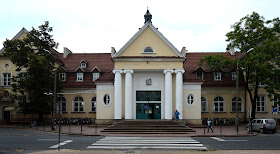Poland has some lovely examples of railway station architecture. Here is Grodzisk Mazowiecki station, along Line No. 1 (Warsaw-Katowice). Some 30km from W-wa Centralna, Grodzisk Maz. as a town exudes more wealth than other places a similar distance from Our City, wealth created recently on the influx of manufacturing plants and distribution centres.
The current building replaces the original station (opened in 1845), which was badly damaged during WW1. Built in the early 1920s, its architectural style is Polish Dworkowy, the dworek being the manor house beloved of the landed gentry. A style that made a come-back in the 1990s, but is now less in favour among architects and their clients. However, in this guise, it is a style most befitting a railway station serving an exurban community of 30,000 with strong transport links to the capital.
Below: the front elevation, seen from ul. 1 Maja. A balanced composition, pleasing to the eye. I like deep attics that have more than one floor; I wonder what's up there in the station attic? The steps leading up to the main entrance are wooden. Awaiting replacement, or simply wooden steps?
Below: the elevation facing the tracks. Note the 1930s shelters, similar to those that grace the platforms of the stations on the line running towards Otwock. And the metal-plated clock tower, and buttressed end wall. We can't see the typeface of the station name carved in stone above the main platform entrance; it is early 1920s and a gem of Polish typography.
Walking in from the street towards the platform, we pass though an airy vestibule (below), reminding me of Polish public buildings from the 1920s, such as Poznań's city hall. As I took this photo, a lady popped out from the buffet (to the left) and asked me to photograph the damp on the ceiling caused, she said, by water dripping down from the blocked-up gutters. Sadly, I had to explain that I was a mere amateur of railway architecture and not working for the local newspaper...
Below: the main ticket hall-cum-waiting room. Note lack of any electronic signage, and the (closed) booth selling PKS bus tickets. But compared to many Polish small towns of its size, I felt a certain confidence about the people in and around the station.
Certainly one of he nicer stations I've passed through; two half-hour long waits here proved Most rewarding. I feel some more Polish inter-war architecture should come to my readers' attention before too very long...
This time last year:
Exorcism by the President's Palace
This time two years ago:
The raging footsoldier - a story about anger
This time three years ago:
Graffiti and street art




No comments:
Post a Comment